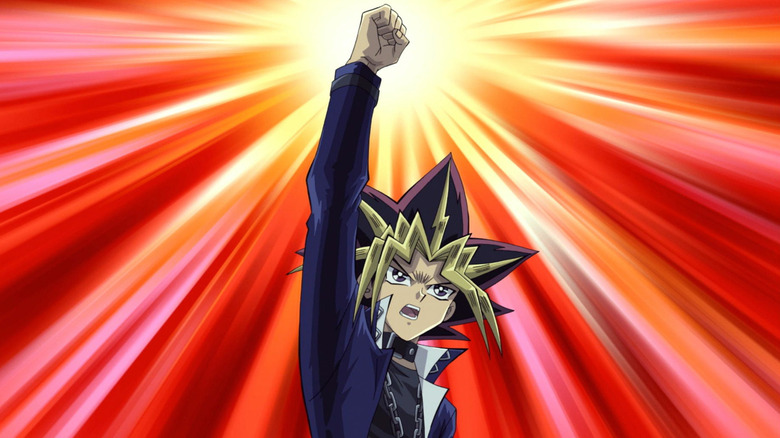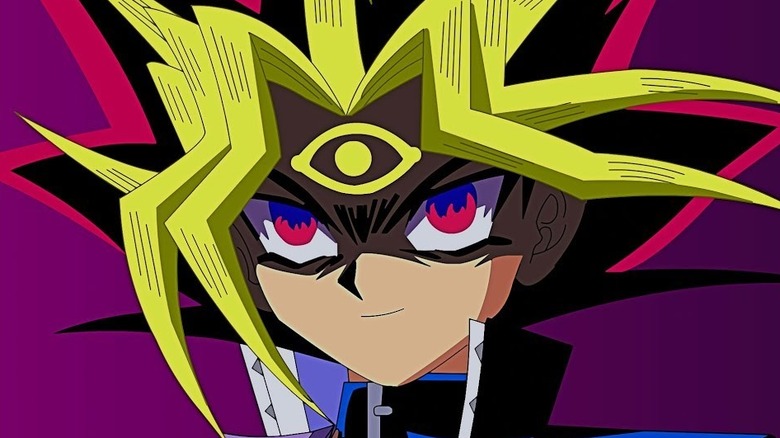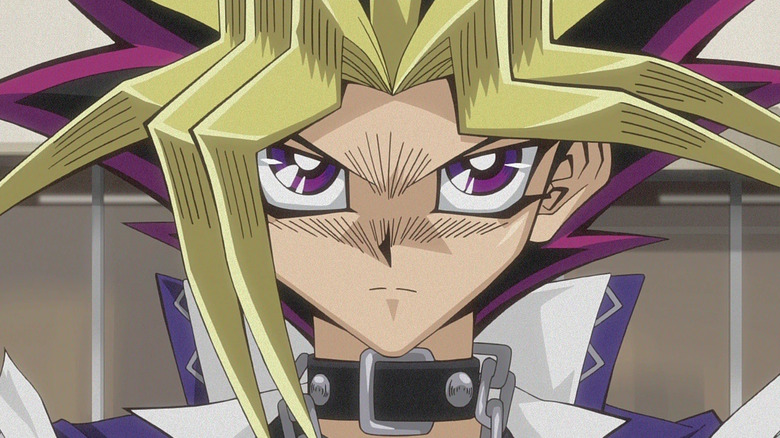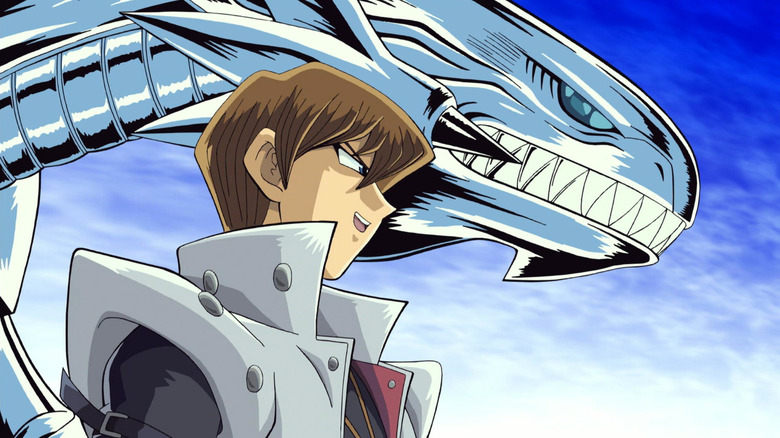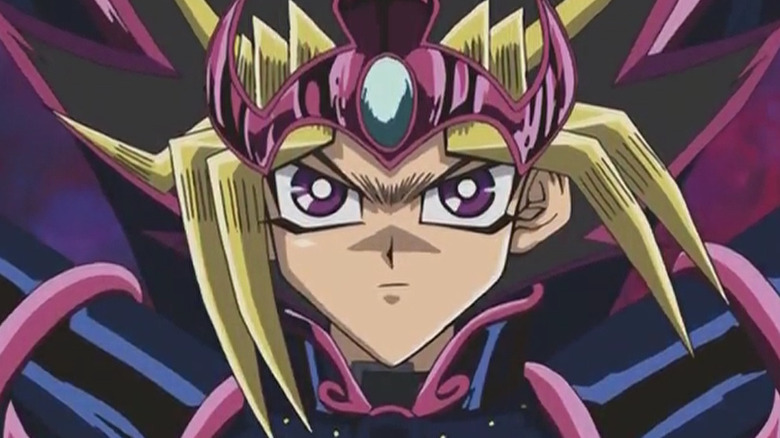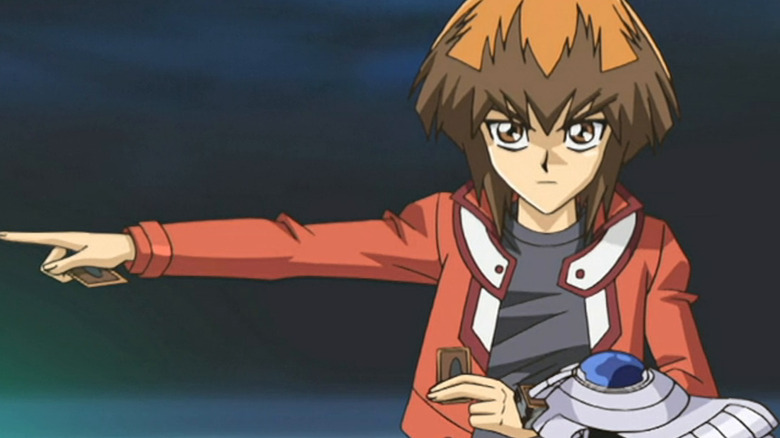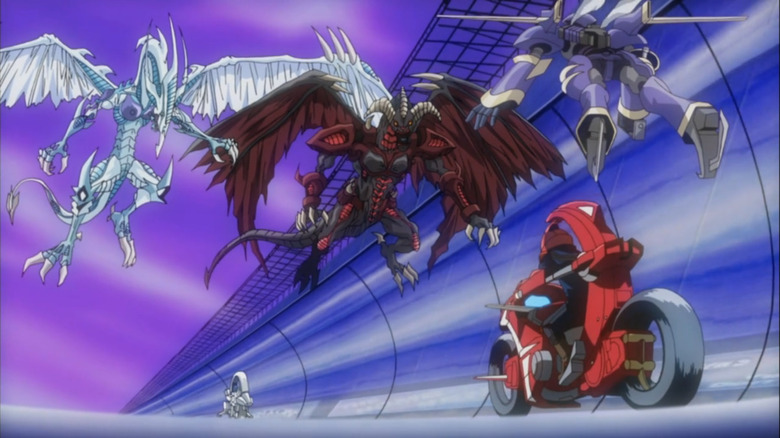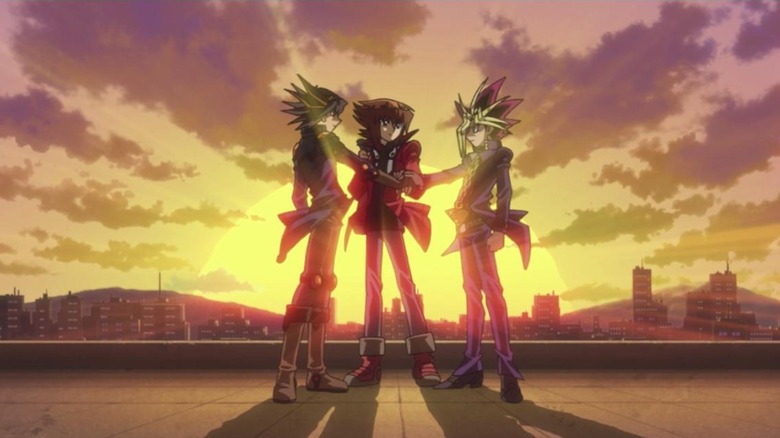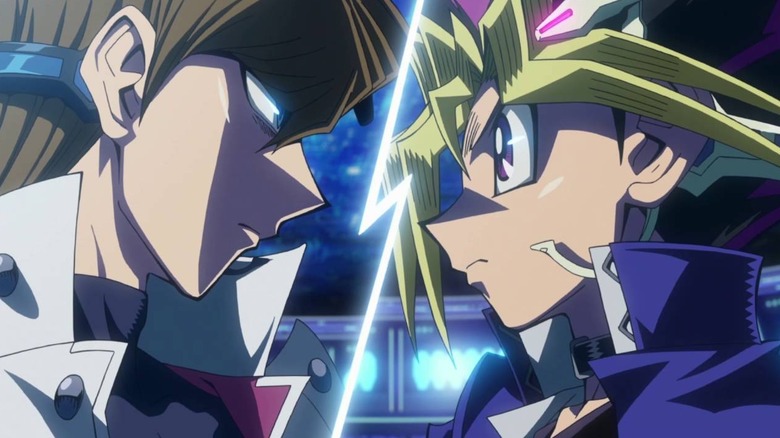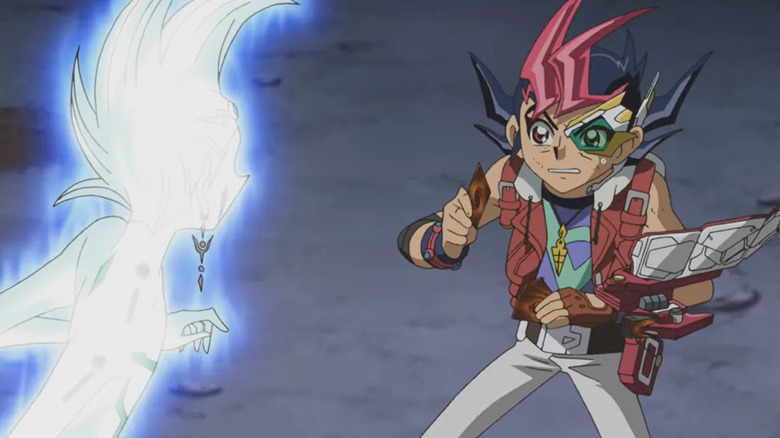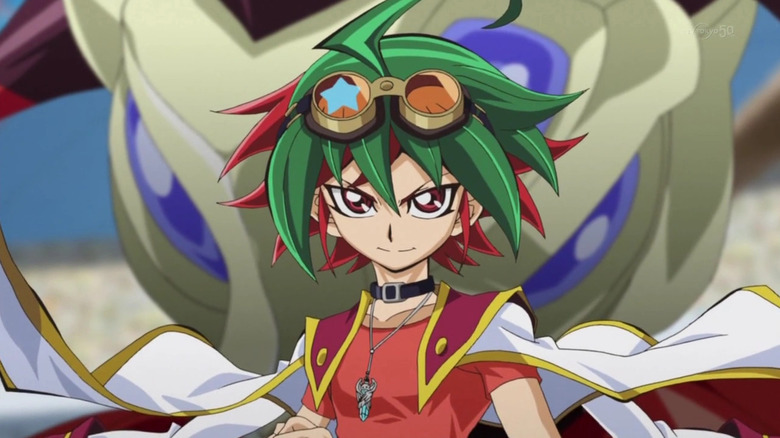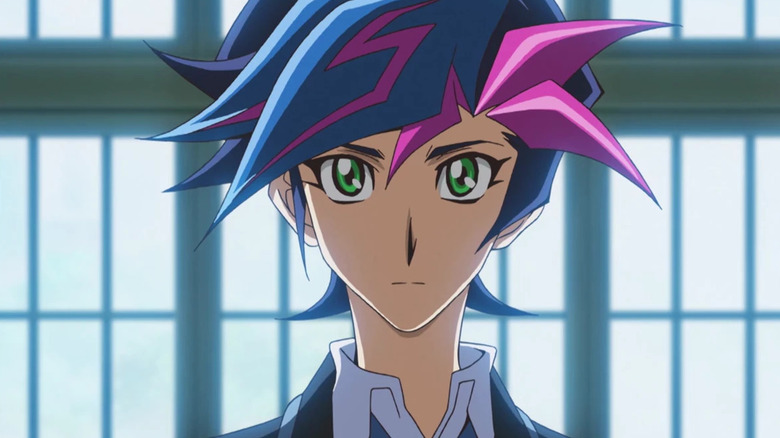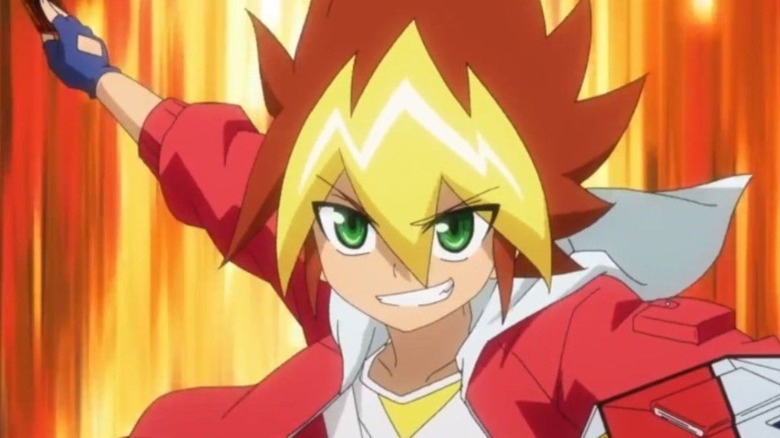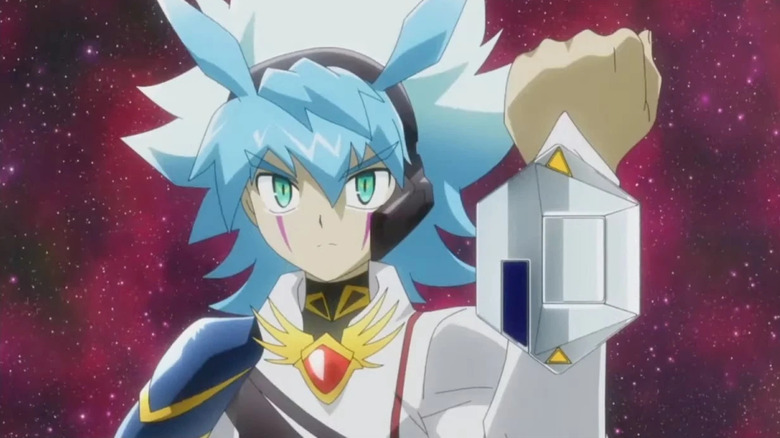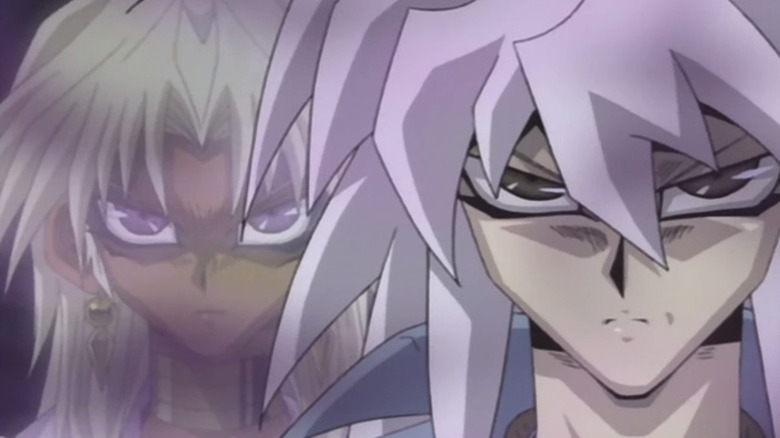The Correct Order To Watch The Yu-Gi-Oh! Franchise
If you're anything like me, a certain segment of your childhood revolved around watching "Yu-Gi-Oh!" The cards were important too, don't get me wrong, but the show is what riveted me — gluing me to the TV every Saturday morning even with the frequently ridiculous dialogue of the 4Kids dub (let's be honest, it's iconic). If that was your childhood too, then you may be surprised to learn just how many different "Yu-Gi-Oh!" shows and movies have come out since then. The franchise has never let up for a second, making the task of watching everything a tall one, to say the least.
Following the original series, there were a few spin-off projects before creator Kazuki Takahashi developed a proper successor to his series, "Yu-Gi-Oh! GX," which blended the original formula with the "magic school" genre. When that was done, he created "Yu-Gi-Oh! 5D's," which put the card games on motorcycles. Both of these sequel shows received a lot of mainstream attention outside of Japan, but the franchise has become a bit more niche in the years since. The shows have kept on coming, though. Along with a handful of animated films, here's the basic list of "Yu-Gi-Oh!" projects in release order, with one notable exception — we've put the 2016 film "Yu-Gi-Oh! The Dark Side of Dimensions" a bit earlier on the list for reasons that I'll explain later. Otherwise, release order is still the best way to watch the property:
-
"Yu-Gi-Oh!" (1998), also known as "Season 0"
-
"Yu-Gi-Oh! Duel Monsters"
-
"Yu-Gi-Oh! The Movie: Pyramid of Light"
-
"Yu-Gi-Oh! Capsule Monsters"
-
"Yu-Gi-Oh! GX"
-
"Yu-Gi-Oh! 5D's"
-
"Yu-Gi-Oh! Bonds Beyond Time"
-
"Yu-Gi-Oh! The Dark Side of Dimensions"
-
"Yu-Gi-Oh! Zexal and Zexal 2"
-
"Yu-Gi-Oh! Arc-V"
-
"Yu-Gi-Oh! VRAINS"
-
"Yu-Gi-Oh! Sevens"
-
"Yu-Gi-Oh! Go Rush!!"
If that sounds confusing, don't worry, it is. Let's break it down a little further and look at some alternative ways to watch for those who don't need to see every single "Yu-Gi-Oh!" project in release order.
Yu-Gi-Oh! (1998)
The first anime adaptation of the "Yu-Gi-Oh!" manga came out in 1998, and if you only discovered the franchise on 4Kids, you may not even know about this earlier version. Often referred to as "Season 0" given that it's set prior to the later, more famous series, this show ran for just 27 episodes, and it's far darker than the adaptation that came after.
In keeping with the manga, this series is less interested in the Duel Monsters card game and more interested in games in general, with the Pharaoh spirit Yami acting as a kind of cruel vigilante toward evildoers he encounters. The show gets downright brutal at times, and because of this stark tonal difference, many might have a more palatable time starting with the second "Yu-Gi-Oh!" TV series and skipping this one altogether.
That said, there are reasons why we've still included it here. It is technically the beginning of the story, and it includes some important story beats like Yugi completing the millennium puzzle, encountering Yami for the first time, and becoming friends with Katsuya Jonouchi and Hiroto Honda — Joey Wheeler and Tristan Taylor in the English localization. These beats are worth seeing, and if you're really taking a completionist mindset to the "Yu-Gi-Oh!" franchise, this is definitely the place to start. But there's also some overlap with certain storylines from the first season of the next TV adaptation, so just know that you can choose to skip this one if you're less dedicated to watching everything.
Yu-Gi-Oh! Duel Monsters
This is the show that brought American audiences into the "Yu-Gi-Oh!" world back in the early 2000s, and it's the one that fans worldwide still think of first when it comes to the franchise. "Yu-Gi-Oh! Duel Monsters," also known simply as "Yu-Gi-Oh!" colloquially, tells the story of the eponymous card game, resurrected from ancient Egyptian "Shadow Games" and played out with cutting-edge holographic technology. This remains both the foundation and the pinnacle of "Yu-Gi-Oh!" — Seto Kaiba, the Blue-Eyes White Dragon, the Dark Magician, Marik Ishtar, all the hits.
There are five seasons of "Yu-Gi-Oh! Duel Monsters," and my general recommendation is that you watch them all in order uninterrupted for the best viewing experience. That said, there are a couple of spin-off projects that take place during the events of the show, but which were released after the Japanese series had finished airing. Because neither are hugely significant in the grand narrative scheme, they're best viewed as bonus material after you finish the main show, rather than as additional chapters retroactively slid into the central story. That said, we'll outline below where to slot them into the timeline should you choose to do so.
Yu-Gi-Oh! The Movie: Pyramid of Light
"Yu-Gi-Oh! The Movie: Pyramid of Light" is a curious entry in the franchise, to say the least. It's a feature-length, theatrically released film written and produced by an American team from the 4Kids side of the "Yu-Gi-Oh!" series, rather than the Japanese arm. And since it came out in 2004, the Japanese anime series was just wrapping up its run, but the American localization was right in the middle of the story, meaning that western fans saw the film before the last couple seasons of the show.
If handing creative control over to a localization team sounds like a bad idea, it was, and the film bombed both commercially and critically. That said, there's still some fun to be had here. Yugi and Kaiba duel, which is always the main attraction, and there's some new supernatural Egyptian lore. Technically, this side story takes place between the Battle City Tournament Finals at the end of season 3 and the beginning of season 4 (between episodes 144 and 145, to be exact). It works well enough as a little tangent, but you could also save it to watch (and likely chuckle at) after finishing the main show.
Yu-Gi-Oh! Capsule Monsters
The other big "Yu-Gi-Oh! Duel Monsters" spin-off project is "Yu-Gi-Oh! Capsule Monsters," which, like the "Pyramid of Light" movie, was produced by 4Kids. But while the film was at least still released in Japan, "Capsule Monsters" never was, making it an exclusive series for international markets.
If you want to watch everything in chronological order, this show technically takes place in the middle of season 5 between the two main arcs of that season (or between episode 198 and episode 199, specifically). But again, this story is fully self-contained and can therefore be watched as a bonus. If you don't want to waste too much time adding fluff to the main series. "Capsule Monsters" is only 12 episodes long and features a brief journey into a magical realm, some copyright-questionable "Pokémon" similarities, and a deceptive teapot. Is it great? Not really, but hey, it is still technically "Yu-Gi-Oh!"
Yu-Gi-Oh! GX
Now that you've watched two different adaptations of the original "Yu-Gi-Oh!" manga and two different American-made spin-offs, you can finally dig into the official sequel series, "Yu-Gi-Oh! GX." Unlike the original series, which features a number of different locations in a globetrotting narrative structure, "GX" takes place almost entirely at Duel Academy — a Hogwarts-esque school for playing card games founded by Seto Kaiba.
"GX" often gets a bad rap from American fans because of its frequently cringey localization, and also because, unlike the original series, the dub for "GX" was never completed at 4Kids. As a result, the story was left hanging for western viewers, though there are ways to watch the Japanese version subtitled these days, including on Crunchyroll. The series is also being remastered in 2025 for its 20th anniversary, so if you wrote it off back in the day, it's definitely worth a proper try. "GX" may surprise you; just be prepared for some decidedly YA magic school vibes.
Yu-Gi-Oh! 5D's
The third mainline "Yu-Gi-Oh!" series, "Yu-Gi-Oh! 5D's," blends the traditional Duel Monsters game with cyberpunk motorcycle racing — a natural match, of course. If you watched any Martin Billany content on YouTube back in the day, you probably know the show better as "Card Games on Motorcycles," which I definitely didn't have emblazoned on a t-shirt as a teenager...
But I digress.
"5D's" takes place in the same timeline as "Duel Monsters" and "GX," but set a ways further in the future. Yugi Moto's home of Domino City is supplanted by New Domino City, and the old card games of yore are replaced by high-speed "Turbo Duels." Like the two series preceding it, "5D's" was localized on 4Kids, and as with "GX," some episodes were cut. Subtitled versions of the original Japanese episodes aren't too hard to come by these days, though.
Yu-Gi-Oh! Bonds Beyond Time
The next "Yu-Gi-Oh!" movie came out in 2010 in Japan, near the end of "Yu-Gi-Oh! 5D's" but still during that show's run. It received limited theatrical screenings in America near the start of 2011. So, where does it fit into the franchise's chronological timeline? The story starts with the "5D's" characters in the middle of season 3, though there is some debate among fans as to where exactly you should watch it if you want to keep things strictly chronological. Most recommend watching the film after episode 84 of "5D's" (or season 3, episode 20 in the localized counting system).
You can absolutely slot the movie in there, but you're not missing too much if you leave it to watch until after "5D's" is fully over. The film itself uses a time-travel conceit to put the protagonists of the three main shows — Yugi Moto, Judai (or Jaden) Yuki, and Yusei Fudo — in the same place, all dueling together against an enemy called Paradox. Watching the film after finishing "5D's" is also a nice wrap-up to the original trio of shows, as the timeline gets much more complicated and less connected after that. But since "Bonds Beyond Time" is less than an hour long, you can easily slot it in during the show if you so choose.
Yu-Gi-Oh! The Dark Side of Dimensions
"Yu-Gi-Oh! The Dark Side of Dimensions" is the one big departure in this timeline from the main "Yu-Gi-Oh!" release order. The film came out in theaters in 2016, but it focuses solely on the characters from "Yu-Gi-Oh! Duel Monsters" and is set after the events of that show. If you wanted, you could watch this film directly after finishing season 5 of the original series, but it also works as a nice follow-up to "Bonds Beyond Time" with a bit more meat on the bone.
Like the prior film, "The Dark Side of Dimensions" makes for a nice send-off to this earlier generation of "Yu-Gi-Oh!" before it jumps into the alternate realities of "Zexal" and beyond. It's a fun adventure with some nice animation and some particularly good fan service for the Kaiba lovers out there (guilty).
Yu-Gi-Oh! Zexal and Zexal 2
Following the end of "Yu-Gi-Oh! 5D's," the franchise took a bit of a hard left turn in terms of narrative structure. The next series, "Yu-Gi-Oh! Zexal," is generally believed to exist in a totally separate continuity from the preceding shows, though that's not hard canon. There are some fans who argue the series simply exists in a far-flung future, but given that the later shows after "Zexal" get pretty deep into parallel realities, the first theory feels more plausible. Regardless, from this point on, the series can be watched in straight-up release order, making things pretty simple.
Narratively, "Zexal" has a decent amount in common with both "5D's" and "GX." The story follows young protagonist Yuma Tsukumo on a journey to become the greatest Duel Monsters player out there. Along the way, he gets roped into some world-threatening supernatural shenanigans, as is surely written in the stone tablets from which every "Yu-Gi-Oh!" series is adapted.
"Yu-Gi-Oh! Zexal 2," while a different series in name, takes place immediately after the first show, so you basically think of the two as halves of the same series.
Yu-Gi-Oh! Arc-V
"Yu-Gi-Oh! Arc-V" is where the multiversal shenanigans of the later "Yu-Gi-Oh!" shows really start to kick into high gear. Centered on the young duelist named Yuya Sakaki, the series takes place in a whole new continuity from any past shows, but as the plot gets moving, it also pays direct homage to many previous series. Dueling in Yuya's dimension comes to revolve around a technique called Pendulum Summoning, and he encounters characters from other dimensions where different dueling techniques are paramount — one for Fusion Summoning, one for Xyz Summoning, and one for Synchro Summoning.
Since those techniques are core respectively to "Yu-Gi-Oh! GX," "Yu-Gi-Oh! Zexal," and "Yu-Gi-Oh! 5D's," the realities associated with each style are homages to those shows, with many characters from them reappearing. These reprisals aren't technically the same people, but rather alternate-universe versions of the characters from the older shows. Even still, having watched all the prior series before jumping into "Arc-V" will make sure you get the most out of all the callbacks and references.
Yu-Gi-Oh! VRAINS
Similar to "Zexal," "Yu-Gi-Oh! VRAINS" is tricky to place on a timeline, as it either takes place in the future of the original timeline or in its own separate continuity. Either way, you should watch it after finishing "Arc-V," as it was the next series to be released.
"VRAINS" takes the "Yu-Gi-Oh!" franchise's longstanding interest in cyberspace and artificial intelligence and makes it the whole premise of the show. The series revolves around a virtual reality space called the Cyberse World, where various battles large and small take place. At this point, you know the drill. There's a city, there's a protagonist whose name starts with "Yu" (Yusaku Fujiki, in this instance), and there's a new summoning mechanic (Link Summoning).
Yu-Gi-Oh! Sevens
After "Yu-Gi-Oh! VRAINS" comes "Yu-Gi-Oh! Sevens," not to be confused with the real-world sport variant Rugby Sevens. Again, the formula plays out: In a futuristic city, a young duelist named Yuga Ohdo devises a new dueling technique called Rush Dueling and strives to be the best while contending with some shadowy institutional villains.
"Sevens" premiered in 2020 and ran for just 92 episodes in Japan — the shortest run up that point for a "Yu-Gi-Oh!" show if you count "Zexal" and "Zexal 2" as one series. Like most of the shows from this more modern "Yu-Gi-Oh!" era, "Sevens" exists in its own distinct continuity.
Yu-Gi-Oh! Go Rush!!
The latest addition to the "Yu-Gi-Oh!" franchise — "Yu-Gi-Oh! Go Rush!!" — premiered in 2022. Unlike many of the later-model shows, "Go Rush!!" has a direct link to its predecessor, though it's not quite as simple as just being a sequel to "Sevens." Much of the story actually takes place prior to the events of the previous show, but you should definitely watch it second because of how they line up.
Narratively, "Go Rush!!" puts a more classical sci-fi spin on the usual "Yu-Gi-Oh!" formula by introducing aliens. The Rush Duel mechanic from "Sevens" remains central as well. For now, this is the final mark on the "Yu-Gi-Oh!" timeline, though as you can see, it's less of a line and more of a web.
Is there another way to watch Yu-Gi-Oh!?
As outlined throughout this article, there are some tweaks you can make to your overall "Yu-Gi-Oh!" viewing experience, if you so choose. For many, it will make more sense to start with the second anime adaptation of Kazuki Takahashi's original manga and skip the 1998 series entirely, leaving it as a bonus for later. The first show doesn't really set you up for the tone of the rest of the franchise, even if it is fascinating in its own way.
For a truly chronological viewing of "Duel Monsters," "GX," "5D's," and their spin-offs, you should watch "Pyramid of Light" between "Duel Monsters" seasons 3 and 4 and "Capsule Monsters" in between the two main arcs of season 5. You should then watch "The Dark Side of Dimensions" before moving on to "GX," returning after "5D's" episode 84 to watch "Bonds Beyond Time." Alternatively, if you're exclusively watching the Japanese versions of things, you can skip "Pyramid of Light" and "Capsule Monsters" altogether, especially the latter.
As for the later shows, you really have a lot of freedom to jump around as you wish and just pick what's interesting, as most of them exist in their own isolated continuities. Just make sure to have seen "Duel Monsters," "GX," "5D's," and both "Zexal" shows before watching "Arc-V," and don't start "Rush Go!!" before finishing "Sevens."
